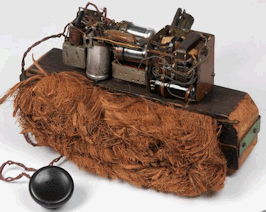Secret Wireless in a Broom
PoW's in Changi Prison made a secret wireless to hear news of the war.
After returning from the Thai - Burma Death Railway, Bob Kelsey spent the rest of the war in Changi Prisons, working in various jobs from the wharves, to the vegetable gardens, binding books in the library, in the steam laundry and constructing the runways at the new Changi aerodrome. He was approached by a senior officer with links to the British High Command about taking on something that was very dangerous - if he were caught the penalty would be death by shooting or be-heading and subsequently others living in the same hut would also be executed. Bob agreed and was transferred by his immediate command to a different bunk in Hut E1. (Sketches by RHSK of Hut E1 and the radio operations)
He soon began his new role - apart from daily work - as lookout for the person in the bunk below (The Australian term is "cockatoo"). The bunk below belonged to Russel Wright, a British PoW, who had built a 3 valve wireless into a broom which he secretly operated in captivity despite great risk to his life. The aerial was sewn into the hem of Rus's mosquito net which was always left hanging up, then upwards into Bob's bunk. The PoW's convinced the Japs that an electric cigarette lighter by the door would be a good idea, so one was positioned at the doorway which then provided a power source for the wireless. To distract the Japs there was a crudely made electric clock mounted on the wall to distract roving eyes from any loose wiring.
During the day the broom stood up against the wall and was never moved. For over 10 months no one else in the hut knew of the wireless. Wright would listen to the news and write messages which he passed to an unknown hand that appeared from the darkened doorway - this way if one was caught the other would be unknown. This was a high stake game - the penalty for being caught was death!
 |
 |
| After libreation PoW Bob Kelsey demonstrating the wireless. Note there was no headphone. | Demonstration of the operation of the wireless L. to R. - PoW's Scotty Ureo, Russel Wright with the listening tube in his ear, Nev. Garvey, Noel Anderssen. |
It would appear that the "wireless in a broom head" found it's way to England after the Jap. surrender and is still part of the Imperial War Museum collection in London
 |
 |
 |
 |
| Improvised wireless/radio receiver associated with the Second World War experiences, as a prisoner of war (POW), of Russell Francis Wright (8th Australian Division, Australian Army - 2nd Australian Imperial Force - [not so Wright was a British PoW]). Radio hidden in the head of a broom built secretly in Changi in 1944. A report written within days of the Japanese surrender in 1945 by the Senior British Officer at Changi stressed the importance of radios. He wrote: 'Regular and reliable news was absolutely necessary to maintain the morale of all ranks' and added that the prisoners 'responsible for the actual working of the sets...daily carried their lives in their hands.' The radio was brought back by one of the officers responsible for maintaining and operating it. This radio was constructed in 1944 by Allied POWs from various pieces of equipment and hidden in a broomhead. It was tuned by screwdrivers and was listened to in Changi Jail, by monitoring BBC, All India Radio, South East Asia Command and Radio Tokyo transmissions. Other Allied and Japanese transmissions provided further information, which provided a significant boost to morale. Lieutenant Wright was subsequently awarded the MBE for his conduct whilst a Far East POW. |
|||





